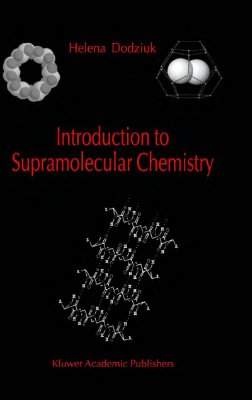Print 2002 Kluwer Academic Publishers
Dordrecht
Supramolecular chemistry emerged only a few decades ago but it is developing rapidly despite the lack of a precise definition of this domain. Interacting with chemistry, physics, biology, and technology it is gaining its strength from fruitful collaborations of researchers representing these diverse fields. It promises, on the one hand, a better understanding of processes in living organisms on the molecular level and, on the other, numerous applications which will change our everyday life. A supermolecule, the subject of study in supramolecular chemistry, is composed of molecules and/or ions held together by weak nonbonding interactions. Weak, but numerous, these interactions may dramatically change the properties of constituent parts of the association. Anions of alkaline metals created owing to a high affinity of cryptands to these metals, nitrogen atoms and He2 and Ne2 molecules isolated in fullerene cages, and stable, otherwise short-lived, species obtained in 'molecular flasks' are probably the most spectacular examples of nontrivial effects resulting from the supermolecule creation. The aim of this book is an introductory presentation of this fascinating field to research scientists working in related areas and to Ph.D. students. It will be useful to specialists as well since it gives a comprehensive, fully referenced, concise and balanced view of the subject. The book is divided into two parts.
General ideas constituting the basis of supramolecular chemistry, its interdisciplinary character, present and future potential applications are presented in the first part. The second part gives a brief but complete overview of important groups of compounds and systems involved. I have been fascinated by their variety and by prospects of industrial applications and hope to transmit my fascination to the reader.
Dordrecht
Supramolecular chemistry emerged only a few decades ago but it is developing rapidly despite the lack of a precise definition of this domain. Interacting with chemistry, physics, biology, and technology it is gaining its strength from fruitful collaborations of researchers representing these diverse fields. It promises, on the one hand, a better understanding of processes in living organisms on the molecular level and, on the other, numerous applications which will change our everyday life. A supermolecule, the subject of study in supramolecular chemistry, is composed of molecules and/or ions held together by weak nonbonding interactions. Weak, but numerous, these interactions may dramatically change the properties of constituent parts of the association. Anions of alkaline metals created owing to a high affinity of cryptands to these metals, nitrogen atoms and He2 and Ne2 molecules isolated in fullerene cages, and stable, otherwise short-lived, species obtained in 'molecular flasks' are probably the most spectacular examples of nontrivial effects resulting from the supermolecule creation. The aim of this book is an introductory presentation of this fascinating field to research scientists working in related areas and to Ph.D. students. It will be useful to specialists as well since it gives a comprehensive, fully referenced, concise and balanced view of the subject. The book is divided into two parts.
General ideas constituting the basis of supramolecular chemistry, its interdisciplinary character, present and future potential applications are presented in the first part. The second part gives a brief but complete overview of important groups of compounds and systems involved. I have been fascinated by their variety and by prospects of industrial applications and hope to transmit my fascination to the reader.

